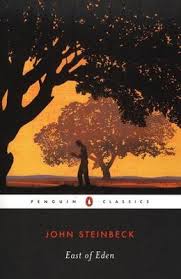East of Eden – Top Shelf
Over at Doorstoppers we tend to read a long classic (or anyway an “older” book) during the summer. I’m not sure why that is but I’m really happy we chose East of Eden, by John Steinbeck, this summer. It’s a new addition to my Top Shelf, my all-time favorite fiction reads (the full list is at my Bookshop.org storefront).
Not a Deep Analysis
As I said in my newsletter, I don’t want to go into some kind of deep analysis of East of Eden. In particular, I don’t feel like I’m the right person to comment on any parallels between the book and the Bible, so I’ll leave that to others who are more knowledgeable in that area. Ditto for any translations of timshel, a word key to the story. If anybody out there wants to share their thoughts regarding either of these aspects, feel free to leave a comment below. That being said, no particular religious knowledge or beliefs are necessary to understand or enjoy the book. This will be spoiler-free.
Limited Experience
Along with not being in a position to do some deep-dive analysis of correlations between the Old Testament and East of Eden, I also have limited experience with John Steinbeck’s writing. The only other book of his that I recall reading is The Pearl. Forced on me in middle school, it was not for me at that time. If you want to get kids interested in reading for school, at least have them read something they might like. Just a thought. Anyway, I’m older and hopefully somewhat wiser by now, and I appreciated this book so much. I mean, THIS BOOK. It’s amazing.
Journal of a Novel
From the first page, I knew East of Eden was going to be one of the Big Ones. The Penguin Classics edition has a fantastic introduction, but I want to hear more from Steinbeck himself, so I immediately ordered his Journal of a Novel: The East of Eden Letters. This book contains letters Steinbeck wrote to his dear friend and editor, Pascal Covici, as he was writing the novel. He used these letters, which were written on the facing pages of his handwritten draft, as a kind of warm-up prior to each day’s writing. And the man handwrote like a freight train, completing the book in under one year (after thinking about the idea for more than 10 years).
The Salinas Valley and the Families
The Salinas Valley in California, where Steinbeck was born, plays a large role in the novel, which takes place from the Civil War to World War I. Steinbeck said that he wanted to write the novel for his sons, and so I think he also wanted to chronicle the Valley during a time prior to their birth. The two main families in the story are the Hamiltons (loosely based on Steinbeck’s maternal grandmother’s family) and the Trasks. Or, should I say the Trasks and the Hamiltons? The Hamiltons fade out of the story as it goes along, although they’re present for most of it.
Steinbeck has the role of narrator in the story at some points of the story. He makes a brief appearance as himself, so brief that some Doorstoppers members didn’t even pick up on it. Most of the narrative, though, is from an omniscient point of view.
Approachable Style and Favorite Characters
East of Eden has an extremely approachable style. It, like Lonesome Dove, another Doorstoppers favorite, flows easily, with its somewhat large number of pages no real barrier to finishing. Aside from the style, it has one of the best villains ever: Catherine/Kate. True evil. My favorite character, though, is Lee, Adam Trask’s “butler” and companion. He is instrumental to the story and so powerful! His growth in his own and others’ estimation is inspirational. I also found Abra, Aron’s childhood friend and then girlfriend, to be an exceptionally strong character.
The best part about all of the characters is that they’re so relatable. They’re human, totally fallible, and do things that are wrong. But you can see yourself doing the same things (well, with the exception of Catherine). The various story arcs aren’t that important. There’s plenty of story, but it’s the overall feel and the fight of good against evil that sticks with you. The poetic writing is neither labored nor difficult. It’s like slipping into warm ocean waters and floating along for awhile.
Addressing the Issue of Racism
I’ve read complaints that Steinbeck wrote racist things or didn’t address the issue of racism in a satisfactory way (for example, in Of Mice and Men). There’s a jarring line near the beginning of the East of Eden about Native Americans, and one character, in particular, has a pejorative name. It’s capitalized and, in general, she’s spoken about respectfully, so that’s…good? As time progresses, though, the negative lens is turned on those who assumed others were stupid or lazy (see below).
In addition, one of the best-developed characters is Lee, a Chinese-American. He’s also a character much loved by others in the book. My gut feeling is that Steinbeck wrote what he knew, and his experiences growing up in the Salinas Valley when he did may not have included a lot of day-to-day exposure with Black Americans. I doubt his empathy for the poor didn’t extend to poor Black Americans. It’s hard to tell from this book. As a writer, it’s impossible to include everything and everybody in your story. And omitting some people from your story doesn’t necessarily make you a racist.
Notes of Criticism
From what I know of Steinbeck’s level of caring for the underprivileged and working class, any references in the book that come across as racist may not be reflections of his own opinions. As I said, we get slammed with a very negative comment about Native Americans in the first couple of pages, but immediately after that comment, the omniscient narrator proceeds to slam the people who settled the land afterwards, which includes white settlers. (“Then the hard, dry Spaniards came exploring through, greedy and realistic, and their greed was for gold or God.” and “Then the Americans came — more greedy because there were more of them.”)
I gleaned notes of criticism or satire in some instances, and I had the feeling that overall views shifted and evolved as time went by (as one would hope). For example, Americans in the book were generally disabused of the notion that Mexicans “can’t shoot straight and besides were lazy and stupid” during their experience fighting against Pancho Villa: “When our own Troop C came wearily back from the border they said that none of this was true.”
We Went Right Back to Our Myths
And when World War I rolled around, “Somehow we didn’t connect Germans with Mexicans. We went right back to our myths” (emphasis added). In another, somewhat less charged instance, the narrator states: “There were certain advantages in attacking gambling. One could discuss it, which was not true of prostitution. It was an obvious evil and most of the games were operated by Chinese. There was little chance of treading on the toes of a relative.” This was simply a fact at the time. Everyone knew the non-Chinese were willing participants in both the gambling and prostitution houses, so criticism of those institutions became criticism, in effect, of the participants themselves.
Upcoming Netflix Series
Shifting gears, I’m excited to watch the upcoming Netflix series starring Florence Pugh, among others. It should be out in 2026, so let’s see if that happens.
In Good Company
I recently read that East of Eden is one of Jamie Lee Curtis’s favorite books of all time. She stated in this interview, “There are passages in this book that have shaped my life.” That’s extremely high praise, and I feel like I’m in good company if we share such admiration for the book.
The Magic of the Words
In the end, you could debate the religion, philosophy, translation, omissions, etc. in East of Eden, but I’m in it for the poetry and magic of the words. I thoroughly enjoyed every single one of the 600 pages. I know I could pick up my copy at some point in the future, flip to a random page, and enjoy the experience of reading only that page if that’s all I have time for. It’s a rare book that you can say that about.
How about you? Have you read East of Eden? Any other books by Steinbeck? If so, what do you recommend? Aside from The Grapes of Wrath, I have been thinking about reading The Moon is Down. What do you think?
Pulling at Threads is my occasional newsletter. It always accompanies my blog posts. If you want more of an “insider’s” view on what’s happening in my reading and writing life (or just to get notified of the latest post), you can sign up here.


